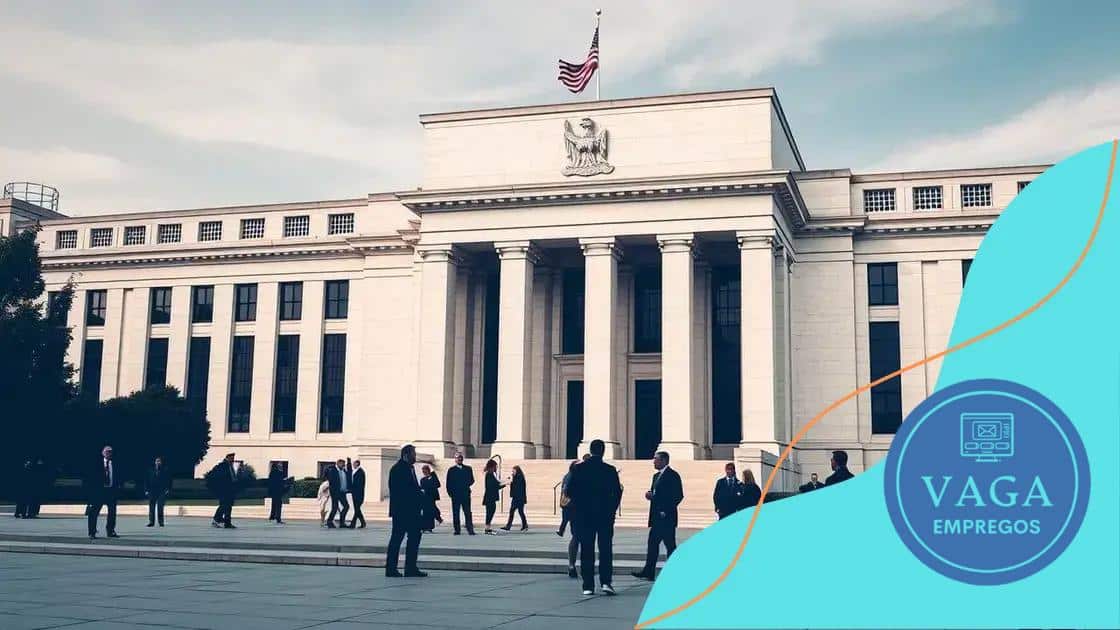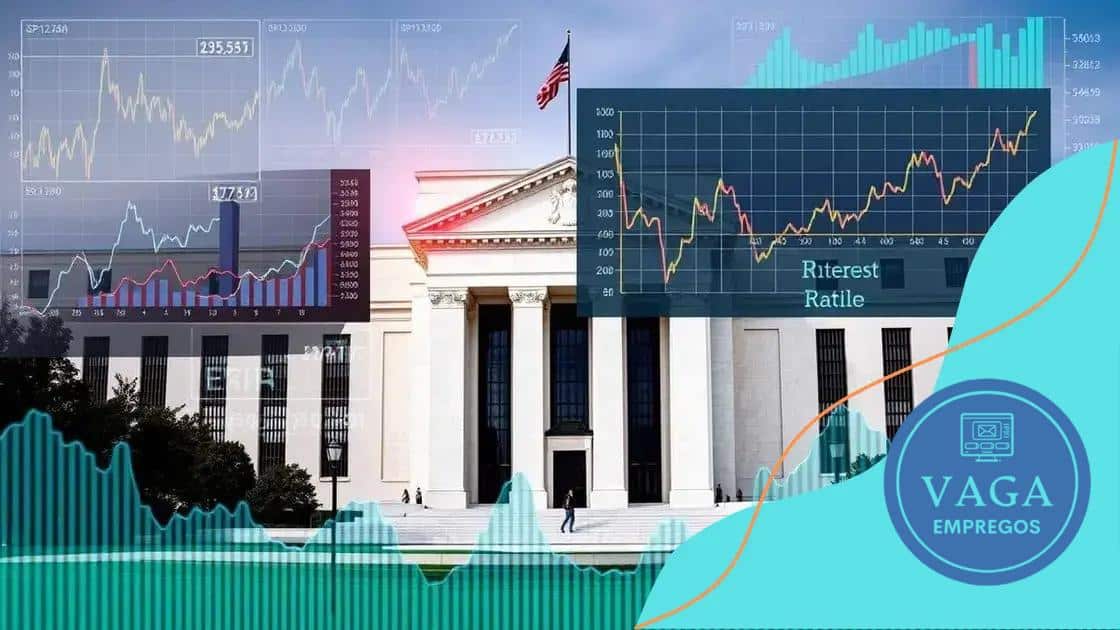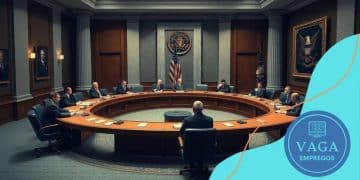Possible interest rate changes by the Federal Reserve explained

Advertisement
Possible interest rate changes by the Federal Reserve significantly impact borrowers and savers, influencing borrowing costs, savings returns, and overall economic conditions based on factors like inflation and economic growth.
Possible interest rate changes by the Federal Reserve shape financial landscapes and influence everyday decisions. Curious about how these adjustments impact your finances? Let’s dive in!
Advertisement
Understanding the Federal Reserve’s role
Understanding the Federal Reserve’s role is crucial for anyone interested in how the economy functions. The Federal Reserve, often called the Fed, is the central bank of the United States. Its primary purpose is to manage monetary policy to promote effective employment and stable prices.
Advertisement
The Fed has several key responsibilities that impact the financial system and the economy.
Key Responsibilities of the Federal Reserve
The main tasks of the Federal Reserve can be summarized as follows:
- Monetary Policy: The Fed controls the money supply and interest rates to foster economic stability.
- Regulation of Banks: It oversees banks to ensure they operate safely and soundly.
- Financial Services: The Fed provides various banking services for the government and other financial institutions.
Monetary policy decisions are made through open market operations, controlling the federal funds rate, and adjusting reserve requirements for banks. Each of these tools has a direct influence on the economy.
Understanding these mechanisms helps individuals anticipate how changes in interest rates might affect their own finances. For example, when the Fed raises rates, borrowing costs increase, which can slow down economic growth. Conversely, lowering rates can stimulate spending and investment.
Investors and consumers alike should pay attention to the Fed’s announcements and the economic indicators that guide its decisions. This way, they can better position themselves for potential market changes.
In summary, the Federal Reserve plays a pivotal role in maintaining the economic balance. By managing interest rates and overseeing the banking system, it seeks to promote stability and growth in the economy.
Factors influencing interest rate decisions

Several factors influencing interest rate decisions play a critical role in shaping economic conditions. The Federal Reserve carefully considers these factors in its assessments.
Economic growth is one of the primary considerations. When the economy is booming, the Fed may increase interest rates to prevent inflation. On the other hand, during slower economic times, they might lower rates to stimulate growth.
Critical Economic Indicators
There are key indicators that the Federal Reserve examines when making its decisions:
- Inflation Rates: If inflation exceeds the target level, the Fed may raise interest rates.
- Unemployment Rates: A low unemployment rate often leads to higher wages, which can boost inflation.
- Consumer Spending: Strong consumer demand indicates a healthy economy, influencing rate adjustments.
- Global Economic Conditions: International events can impact the U.S. economy, prompting the Fed to act.
Market expectations also influence decisions. Investors watch the Fed’s signals closely. If they believe that rates will rise, they may adjust their behavior accordingly, which can lead to changes in the economy.
The federal funds rate is another crucial element. This rate directly affects the cost of borrowing for banks. Changes in this rate influence loans and credit availability, affecting personal and business finances.
Moreover, the Fed monitors fiscal policies, which can also impact monetary policy decisions. A government that spends aggressively may lead the Fed to raise rates to curb potential inflation.
Potential effects on borrowers and savers
Potential effects on borrowers and savers are significant when the Federal Reserve changes interest rates. The adjustments can create a ripple effect throughout the economy, impacting various financial aspects.
For borrowers, higher interest rates typically mean more expensive loans. This is particularly true for mortgages, car loans, and credit cards. When the Fed raises rates, individuals may find it harder to afford monthly payments.
Impact on Borrowers
Here are some vital effects on borrowers:
- Increased Monthly Payments: Higher interest rates lead to increased costs on existing loans.
- Reduced Borrowing: As loans become more expensive, fewer people may choose to borrow money.
- Strained Budgets: Higher interest costs can strain household budgets, leaving less for savings.
On the other hand, savers can benefit when interest rates rise. They receive higher returns on savings accounts, certificates of deposit, and other interest-bearing accounts. This can encourage individuals to save more.
Impact on Savers
The effects on savers include:
- Increased Savings Returns: Higher rates give savers better earnings on their deposits.
- Encouragement to Save: With better returns, individuals may be more inclined to save for future needs.
- Inflation Considerations: If inflation rises too, the real value of savings may not increase significantly.
However, this dynamic can create a challenging balance for both borrowers and savers. High interest rates benefit savers but can inhibit borrowing, which is necessary for economic growth. Thus, the Fed must carefully consider these effects when making rate decisions.
Historical context of rate changes

The historical context of rate changes reveals important trends and shifts that have shaped the current financial landscape. Understanding these changes can provide insights into how the Federal Reserve has responded to economic conditions over time.
In the past, the Federal Reserve made significant adjustments to interest rates in response to various economic crises. For example, during the 2008 financial crisis, the Fed drastically lowered rates to stimulate economic activity.
Key Historical Events
Several key events illustrate this pattern:
- The Great Depression (1930s): The Fed raised rates to combat speculative investments, which contributed to the economic downturn.
- The Volcker Shock (1980s): In an effort to fight high inflation, Federal Reserve Chairman Paul Volcker raised rates dramatically, leading to a recession but also to subsequent economic recovery.
- The 2008 Financial Crisis: The Fed slashed rates to near-zero levels to support recovery and prevent further collapse of the financial system.
These rate changes have far-reaching impacts beyond immediate economic conditions. They influence consumer behavior, business decisions, and overall market dynamics. For instance, changes in rates can affect mortgage rates, loan costs, and savings returns.
Additionally, public perception and expectations about future Fed actions play a crucial role. When people expect the Fed to raise rates, they might curtail spending and borrowing, which can slow down economic growth.
In summary, the Fed’s historical decisions on interest rates are vital in understanding both past and present economic conditions. These shifts not only reflect the Fed’s response to crises but also influence how future rate changes might be perceived by the public and the market.
Future predictions and market reactions
Future predictions and market reactions are essential aspects to consider when discussing potential interest rate changes. Understanding how the market might respond to these changes can help investors and consumers make informed decisions.
Analysts often look at economic indicators to forecast where interest rates may go. The Federal Reserve’s communications play a crucial role in shaping these expectations. If the Fed signals a potential increase in rates, markets might react immediately.
Factors Influencing Predictions
Several factors shape future interest rate predictions:
- Economic Growth: Strong economic growth may lead to higher interest rates as the Fed tries to control inflation.
- Inflation Rates: Persistent inflation can prompt the Fed to increase rates to stabilize prices.
- Global Economic Events: Events like financial crises or geopolitical tensions can influence rates as they affect overall economic stability.
- Labor Market Metrics: A tight labor market can indicate rising wages, leading to inflation and potential rate hikes.
Market reactions often reflect these predictions. When investors believe that rates will rise, they may move their assets to safer investments, anticipating lower returns on bonds and equities. This shift can create volatility in the market, impacting stock prices and investment strategies.
Conversely, if the Fed indicates a stable or declining rate environment, it can encourage spending and investment. Investors might feel more confident, leading to increased stock prices and economic activity.
Moreover, consumer behavior is influenced by these expectations. If people expect higher rates, they may rush to take out loans before rates increase. This can create spikes in mortgage applications or consumer borrowing ahead of the predicted changes.
In conclusion, understanding potential interest rate changes by the Federal Reserve is vital for both borrowers and savers. These changes can significantly impact the economy, affecting everything from loan costs to savings returns. By keeping an eye on factors such as inflation, economic growth, and market expectations, individuals can better navigate their financial decisions. The interplay between the Fed’s actions and market reactions is crucial in shaping economic conditions. Staying informed helps everyone make smarter financial choices for the future.
FAQ – Frequently Asked Questions About Interest Rate Changes
What factors influence interest rate changes?
Factors such as economic growth, inflation rates, and global events play a significant role in determining interest rate changes set by the Federal Reserve.
How do interest rate changes affect borrowers?
When interest rates rise, borrowing costs increase, making it more expensive for individuals to take out loans for homes, cars, and credit.
What is the impact on savers when rates go up?
Higher interest rates typically lead to better returns on savings accounts and other interest-bearing investments, encouraging individuals to save more.
How do market reactions influence interest rate decisions?
Market reactions can shape the expectations of the Federal Reserve’s decisions, as investors adjust their behaviors based on anticipated rate changes.





